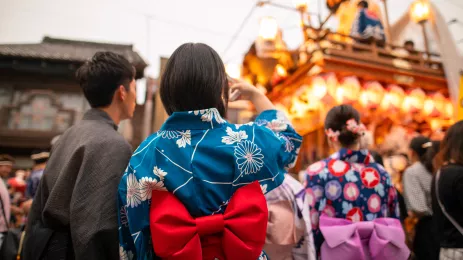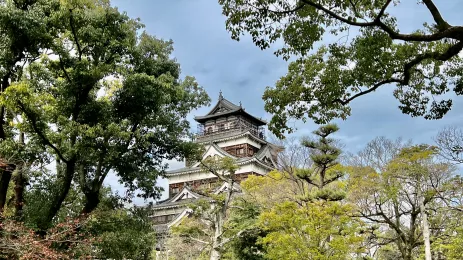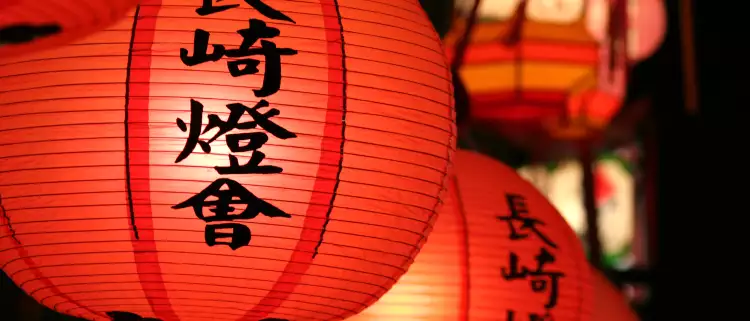Japan is a treasure trove of cultural experiences and natural beauty all year round, but, like Europe, it has four very distinct seasons.
Spring (March to May) is when the city bursts into colour as the iconic cherry blossoms flower across the country. Similarly, autumn (September to November) is popular as it’s when the autumnal colours bleed into the landscapes and cities, red and orange adding a splash of colour. The only downsides to these seasons, though, is that the rest of the world also knows that this is the best time to visit Japan and wants to see this natural beauty, and the main tourist hubs of the country can get crowded.
There is a short rainy season from late May to late June (sometimes bleeding into July), and this is also when the weather starts to heat up. July can be very humid, and August tends to be hot but with less humidity. Then, after that popular autumn period, winter tends to be much quieter across the country – the north gets snowy and is a popular ski destination for Japanese holidaymakers, but you’ll find January and February much quieter and colder in the cities.
We loved this trip. It was superbly well organised, the UK tour manager was excellent, as were the local guides. Accommodation was very good and all in all we think the holiday represented good value for money.

What to expect from Japan in January
As Japan is in the northern hemisphere, January is the middle of winter. Winter in Japan tends to be sunny and dry with low humidity, but temperatures are cold with lows of 2°C and highs of 9°C in January.
Japan celebrates New Year on 1st January, the same as the Western Gregorian calendar, but there is the extremely popular Nagasaki Lantern Festival to celebrate Lunar New Year. This usually falls in late January or February.
It may also surprise you to hear that northern Japan is a ski destination, but it tends to be popular with Japanese holidaymakers over international visitors after snow sports.

Festivals and Events in January
- Nagasaki Lantern Festival (January or February)
- Held in the 2 weeks following Lunar New Year in Nagasaki
- It was started by Chinese settlers in the city, but it’s now spread in popularity
- Lanterns adorn buildings, bridges and streets across the city, particularly Minato Park
- Lanterns range from simple, colourful pieces to intricate depictions of scenes
- There are dances and performances, including Jaodori, a dragon dance with acrobatics and masks

What to expect from Japan in February
February marks the end of winter in Japan. Expect lows of 3°C and highs of 10°C in February, with sunny and dry days with low humidity.
It’s also peak time for snow in Japan, so it’s the best time for skiers to visit the slopes of the north. On the island of Hokkaido, there’s even the Sapporo Snow Festival where visitors can see huge ice sculptures (we’re talking the size of houses for some of them!) and adrenaline seekers can even find ski hills and jumps.

What to expect from Japan in March
March brings with it the start of spring, and temperatures warm up a little, with dry and sunny days. Expect lows of 5°C and highs of 12°C. The end of the month is the start of the famous cherry blossom season, although it’s not a given you’ll be able to see them. Plum blossoms, however, are equally vibrant, and this blooming tends to happen mid-March.
Photo credit - Mary Hodson on Best of Japan Tour 2024.

What to expect from Japan in April
In April, those dry and sunny spring days warm up even more, with lows of 10°C and highs of 18°C.
April is the heart of cherry blossom season in Japan. Also known as Sakura, this beautiful blossoming is more than just a visual feast. Cherry blossoms – or Sakura – symbolise the balance of life and death. The flowers usher in spring, and with it new life, but they also serve as a reminder that life is fleeting, as their beautiful blossoms last only for a short period of time. Cherry blossoms trees can be found across the country, including it the big cities which have vast parks, but it’s impossible to pinpoint exactly which trees will bloom when. But that’s the beauty of Mother Nature!

Festivals and events in April
- Takayama Festival
- A spring festival held at shrines in Takayama’s old town
- Highly decorated floats are displayed in the streets and performances are put on
- There is a procession with a portable shrine, said to hold the deity, paraded to and from the season’s shrine
- There is also an autumn version held in October
- Tsuruoka Cherry Blossom Festival
- The city of Tsuruoka on the north-west coast on Japan is famous for its cherry blossom festival
- This two-week festival runs from mid to late April, and is widely regarded as one of the best places to see them bloom

What to expect from Japan in May
May is generally dry and sunny across Japan, with lows of 14°C and highs of 21°C. The exception to this is on the island of Okinawa which sits far off the south-west coast, close to Taiwan – here’s it’s rainy season!
Generally the cherry blossom season is done by May, except in the far north, including Hokkaido. The main draw in May, though, is Golden Week. Celebrated over the first week of the month, it’s a national holiday and an incredibly busy week for Japanese travellers moving across the country to visit family and friends and take a holiday.

What to expect from Japan in June
There’s a change in weather in Japan in June, as the humidity starts to rise. Temperature-wise, expect lows of 18°C and highs of 24°C, but with rain across much of the country. The upside to this, however, is that the beautiful gardens that Japan is known for become their most verdant!
Photo credit - Gerald Schultz on Best of Japan tour 2021.

What to expect from Japan in July
The first half of July is still rainy season in Japan, but even when the rain clears the humidity sticks around. Temperatures are generally very warm, with lows of 22°C and highs of 28°C.
This is peak season for domestic travel in Japan, and it’s also one of the most popular months to hike Mount Fuji.

Festivals and events in July
- Hakata Gion Yamakasa
- A festival in Fukuoka where extravagant floats are raced through the city
- Kyoto Matsuri
- Held in Kyoto each July
- It began 12 centuries ago as a festival to appease the gods, and is now celebrated with huge floats moving through the city’s streets

What to expect from Japan in August
Just like the UK, August is the peak of summer, and it’s when schools are closed for summer holidays. Temperatures reach lows of 23°C and highs of 29°C, with humidity in many parts of the country.
Photo credit - Riviera Product Manager Will Sarson on Best of Japan tour.

Festivals and events in August
- Gozan No Okuribi
- Also known as Daimonji, it is the end to Obon festival, where the spirits of deceased family members are said to visit this world
- Five giant bonfires are lit on mountains surrounding Kyoto to signify the moment when the spirits return to the spirit world
- Koenji Awa Odori
- Takes place over two days in the summer
- Dance troupes – known as Ren – with a mix of ages and genders perform with musicians, dancing in the streets
- It is one of Japan’s largest festivals with up to 12,000 participants plus over a million visitors
- Aomori Nebuta Festival
- A summer festival that takes place in Aomori in northern Japan
- A large, decorated float depicting a brave warrior – or Nebuta – is lit up and carried around the city
- Costumed dancers dance and chant, asking people to join them

What to expect from Japan in September
Similarly to the UK, September is when the summer heat starts to give way to the cooler autumn temperatures, although it’s still lovely and warm with lows of 20°C and highs of 26°C. It should be dry and sunny and although there may be some lingering humidity at the start of the month, this begins to dissipate nearer the end.
September is a popular time for international travellers to visit Japan, as the children have gone back to school and domestic tourism slows down.

Festivals and events in September
- Kishiwada Danjiri Festival
- Held in Kishiwada, less than 20 miles from Osaka, this festival is held in late September and then again in mid-October
- This festival centres around a huge wooden float, which showcases the work of the district’s best carpenters, with a lot of extravagant detail carved into its surfaces
- Groups dressed in distinctive traditional costume take turns pulling the float through the streets

What to expect from Japan in October
October is one of the best times to visit Japan if you want cooler temperatures and the beauty of the autumn colours. On average, temperatures reach lows of 15°C and highs of 20°C, with clear skies and much lower humidity.
The real draw of October in Japan, though, is nature’s transition from summer to autumn. Green-leafed trees start to turn orange and red, bringing a warm pop of colour to cities and countryside. One of the most popular places to witness the autumn colours in Japan is the Kurobe Gorge. There is a quaint train that crosses a bridge on this tree-clad gorge, giving almost-360 views of autumn colours.

Festivals and events in October
- Takayama Festival
- A Autumn festival held at shrines in Takayama’s old town
- Highly decorated floats are displayed in the streets and performances are put on
- There is a procession with a portable shrine, said to hold the deity, paraded to and from the season’s shrine
- There is also a spring version held in April

What to expect from Japan in November
November is a popular time to visit Japan, especially if you’re trying to avoid the heat. The weather is dry and sunny, and temperatures are mind with lows of 9°C and highs of 15°C.
There’s still a chance to see the autumn trees in November, especially on the south coast of the mainland and in cities like Tokyo.
One of the main draws of Japan in November is the clear skies, which make it a good time to view Mount Fuji. Although you can’t hike Mount Fuji at this time, there are good chances you can see it from one of the many nearby villages and lakes, and snap that iconic photograph!

Festivals and events in November
- Tori no Ichi Festival
- Held at shrines and temples across Japan, this tori festival – meaning rooster festival – is held in November
- It marks the myth of a prince who stopped a tribal uprising on Tori no Hi, or Day of the Rooster
- The prince’s spirit is said to be enshrined at the Otori Shrine in Tokyo
- Ornaments – called kumade – are sold over this period as symbols or wealth and prosperity. The various elements on there - from rice bales to golden coins - all have meanings

What to expect from Japan in December
Early December is a nice quiet time to visit Japan as it’s when winter sets in. Temperatures dip to lows of 4°C and highs of 11°C, but if you’re wrapped up warm, there’s still plenty to enjoy. Just like November, skies are clear and it’s one of the best times to see Mount Fuji and get unobstructed views.
Christmas isn’t a major holiday in Japan, but there may be some lights and trees put up in the cities, making the cold evenings very pretty. However, don’t expect any traditional roast dinner – KFC is actually a Christmas tradition in Japan. Yes, really! The tradition started in the 1970s and now many families pre-order their fried chicken months in advance, and there are queues outside the fast food chain in the days around the 25th December.

Festivals and events in December
- Chichibu Night Festival
- Takes place on the 2nd and 3rd December around 90 minutes from Toykyo
- It’s considered one of Japan’s top three float festivals
- Floats are gilded and hung with lanterns and tapestries, the lights making the most of the darker days of December
- There’s a fireworks display lasting over two hours
- Street food stalls sell specialist festival foods and sweet rice wine
This trip was everything I hoped for. The tour manager and local guides were excellent and everything was arranged to perfection.
Frequently asked questions
- The weather in Japan is driest during spring (March and April) and autumn (October and November).
- June and July are the wettest months across the country, and are classed as the monsoon season in Japan.
- January and February are the snowiest months in Japan, particularly in the far north of the country where you’ll find ski resorts.
- Generally the resorts are open December to March, but snow fall is at it’s most in January and February.
- Spring is the busiest time in Japan, as it’s cherry blossom season, and the temperature is warm but not humid, and skies are clear and sunny.
- Early summer is also popular, although cherry blossom season is over.
- August is busy for domestic tourism as the schools finish for the summer, but less so for international travellers.
- To experience Japan at its quietest, visit in the off-peak season from late autumn through.
Average temperatures by month
| Jan | Feb | Mar | Apr | May | Jun | Jul | Aug | Sep | Oct | Nov | Dec | |
| Hiroshima | 9°C | 10°C | 13°C | 18°C | 23°C | 26°C | 30°C | 32°C | 28°C | 23°C | 17°C | 12°C |
| Kyoto | 8°C | 9°C | 12°C | 19°C | 24°C | 27°C | 31°C | 32°C | 28°C | 22°C | 16°C | 11°C |
| Tokyo | 10°C | 10°C | 13°C | 19°C | 23°C | 25°C | 29°C | 31°C | 27°C | 21°C | 16°C | 12°C |
Average rainfall by month
| Jan | Feb | Mar | Apr | May | Jun | Jul | Aug | Sep | Oct | Nov | Dec | |
| Hiroshima | 56mm | 68mm | 109mm | 158mm | 150mm | 252mm | 237mm | 116mm | 192mm | 105mm | 72mm | 48mm |
| Kyoto | 76mm | 81mm | 118mm | 146mm | 159mm | 240mm | 242mm | 179mm | 208mm | 123mm | 86mm | 67mm |
| Tokyo | 47mm | 62mm | 101mm | 122mm | 138mm | 184mm | 132mm | 147mm | 185mm | 174mm | 90mm | 50mm |
















